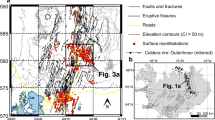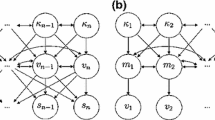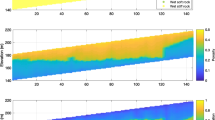Abstract
This work develops a model of the geothermal field in the Nea Kessani region (Greece) by means of the Bayesian maximum entropy (BME) method, which describes the temperature variations across space in the underground geological formations. The geothermal field is formed by a thermal reservoir consisting of arcosic sandstones. The temperature distribution vs depth was first investigated by the Greek Institute of Geology and Mineral Exploration (IGME) using measurements in a set of vertical drill holes. These measurements showed that hot fluids rising from the deep enter the reservoir in a restricted area of the field and flow towards local thermal springs. The field modelling, which was based on the powerful BME concept, involves the solution of a stochastic partial differential equation that assimilates important site-specific information. The stochastic three-dimensional steady-state Laplace equation was considered as general knowledge and the drilling exploration data were used to construct the specificatory knowledge base in the BME terminology. The produced map is more informative and, in general, it gives higher temperature estimates compared to previous studies of the same region. This is also in agreement with the quartz geothermometry analysis carried out by IGME.









Similar content being viewed by others
References
Christakos G (1990) A Bayesian maximum entropy view to the spatial estimation problem. Math Geol 22(7):763–777
Christakos G (1991) Some applications of the Bayesian maximum-entropy concept in geostatistics. In: Grandy WT Jr, Schick LH (eds) Maximum entropy and Bayesian methods. Kluwer, Boston MA, pp 215–229
Christakos G (1992) Random field models in earth sciences. Academic, San Diego
Christakos G (2000) Modern spatiotemporal geostatistics. Oxford University Press, New York
Christakos G, Hristopoulos DT (1998) Spatiotemporal environmental health modeling: a tractatus stochasticus. Kluwer, Boston
Fytikas M, Innocenti F, Manetti P, Mazzuoli R, Peccerillo A, Villari L (1985) Tertiary to Quaternary evolution of volcanism in the Aegean Region. In: Dixon JE, Robertson AHF (eds) Reprint from The Geological Evolution of the Eastern Mediterranean. Special Publication of the Geological Society No. 17. Blackwell Scientific, Oxford, pp 687-699
Grassi S, Kolios N, Mussi M, Saradeas A (1996) Groundwater circulation in the Nea Kessani low-temperature Geothermal field (NE Greece). Geothermics 25(2):231–247
Kitanidis PK (1986) Parameter uncertainty in estimation of spatial functions: Bayesian analysis. Water Resour Res 22:449–507
Kloeden PE, Platen E (1992) Numerical solution of stochastic differential equations. Springer, Berlin Heidelberg New York
Kolios N (1993) Research on the geothermal field of Nea Kessani. Ph.D. thesis, Department of Geology, National University of Athens, Athens (in Greek)
Kolovos A, Christakos G, Serre ML, Miller CT (2002) Computational Bayesian maximum entropy solution of a stochastic advection-reaction equation in the light of site-specific information. Water Resour Res 38(12):1318–1334
Lyberis M (1985) Evolution of the North Aegean Trough. In: Dixon JE, Robertson AHF (eds) Reprinted from The Geological Evolution of the Eastern Mediterranean. Special Publication of the Geological Society No. 17. Blackwell Scientific, Oxford, pp 709–725
Modis K, Sofianos A, Kolovos A (2004) Bayesian maximum entropy solution of the stochastic axisymmetric displacements problem around an excavation, in light of site specific information. In: Agioutandis Z, Komnitsas K (eds) Proceedings of the First International Conference on Advances in Mineral Resources Management & Environmental Geotechnology, Hania, Greece, 2004
Olea RA (1999) Geostatistics for engineers and earth scientists. Kluwer, Boston
Papoulis A, Pillai SU (2002) Probability, random variables and stochastic processes. McGraw-Hill, New York
Serre ML, Christakos G (1999) BME studies of stochastic differential equations representing physical laws, part II. In: Lippard SJ, Naess A, Sinding-Larsen R (eds) Proceedings of IAMG’99: Fifth Annual Conference of the International Association for Mathematical Geology, vol 1. Norway University of Science and Technology, Trondheim, Norway, pp 93–98
Spiegel MR (1974) Theory and problems of Fourier analysis. Schaum’s outline series. McGraw-Hill, New York
Thanassoulas C, Tsokas G (1990) A geothermal field model based on geophysical and thermal prospectings in Nea Kessani (NE Greece). Geothermics 19:77–85
Author information
Authors and Affiliations
Corresponding author
Appendices
Appendix 1
By applying the mean expectation operator on Eq. 6 we get:
Expanding the quadratics in the above expression we finally get
According to Papoulis and Pillai (2002), the joint density for n normal variables that have zero mean is given by
where \(X = \left({\begin{array}{*{20}c} {x_1} \\ \vdots \\ {x_n} \\ \end{array}} \right)\)is the random vector, X T is the transpose vector, \(C = \left({\begin{array}{*{20}c} {c_{11}}& \ldots& {c_{1n}} \\ \vdots& \ddots& \vdots \\ {c_{n1}}& \cdots& {c_{nn}} \\ \end{array}} \right)\) is the covariance matrix and Δ is the determinant of C. In case of two independent normal variables, x and y, with zero mean the exponent of Eq. 16 is
where r xy is the correlation coefficient. For three normal variables x,y and z, the exponent of Eq. 16 becomes
Appendix 2
The conditional density of three normal variables with zero mean is
We also know that
Working only with the exponential parts and working in terms of Eqs. 17, 18 and 20 we find
which is the exponent of f(z|x,y). By comparison with Eq. 19 we get
which define Eq. 14. In order to derive Eq. 15 we have to substitute the random variables in the exponent of f(z|x,y) with ones having non-zero mean values. More specifically, if x= T(s i ), y= T(s j ) and z = T(s k ) are random variables with normal joint density and \( \overline{x} = E[(T({\varvec {s}}_{i} )] = \overline{T} ({\varvec {s}}_{i} ),\quad \overline{y} = E[(T({\varvec {s}}_{j} )] = \overline{T} ({\varvec {s}}_{j} ),\quad \overline{z} = E[(T({\varvec {s}}_{k} )] = \overline{T} ({\varvec {s}}_{k} ), \) then f(z|x,y) is a normal density with exponent \( \frac{{{\left( {(z - \overline{z} ) - \frac{{(x - \overline{x} )\sigma _{z} (r_{{xy}} r_{{yz}} - r_{{xz}} )}} {{(r^{2}_{{xy}} - 1)\sigma _{x}}} - \frac{{(y - \overline{y} )\sigma _{z} (r_{{xy}} r_{{xz}} - r_{{yz}} )}} {{(r^{2}_{{xy}} - 1)\sigma _{y}}}} \right)}^{2}}} {{2( - 1 + r^{2}_{{xy}} + r^{2}_{{xz}} - 2r_{{xy}} r_{{xz}} r_{{yz}} + r^{2}_{{yz}} )\sigma ^{2}_{z} /(r^{2}_{{xy}} - 1)}}, \) and the mean value is given by \( E\{{\mathbf{z}}|x,y\} = z + \frac{{(x - \overline{x} )\sigma _{z} (r_{{xy}} r_{{yz}} - r_{{xz}} )}} {{(r^{2}_{{xy}} - 1)\sigma _{x}}} + \frac{{(y - \overline{y} )\sigma _{z} (r_{{xy}} r_{{xz}} - r_{{yz}} )}} {{(r^{2}_{{xy}} - 1)\sigma _{y}}}, \) or \(\overline T ({\mathbf{s}}_k) = T({\mathbf{s}}_k) + \frac{{(T({\mathbf{s}}_i) - \overline T ({\mathbf{s}}_i))\sigma _k (r_{i,j} r_{j,k} - r_{i,k})}}{{(r_{i,j}^2 - 1)\sigma _i}} + \frac{{(T({\mathbf{s}}_j) - \overline T ({\mathbf{s}}_j))\sigma _k (r_{i,j} r_{i,k} - r_{j,k})}}{{(r_{i,j}^2 - 1)\sigma _j}}\) which is Eq. 15.
Rights and permissions
About this article
Cite this article
Papantonopoulos, G., Modis, K. A BME solution of the stochastic three-dimensional Laplace equation representing a geothermal field subject to site-specific information. Stoch Environ Res Ris Assess 20, 23–32 (2006). https://doi.org/10.1007/s00477-005-0244-6
Published:
Issue Date:
DOI: https://doi.org/10.1007/s00477-005-0244-6




